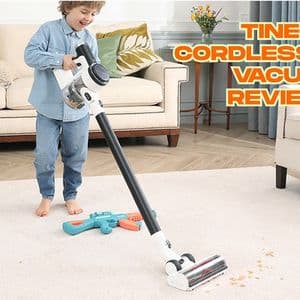Why Stick Vacuums Appeal to Budget Shoppers
Let’s face it: not everyone needs—or wants—a high-end vacuum cleaner. The cheapest stick vacuum can handle small jobs and be a perfect backup tool.
Here’s why many go this route:
-
Affordability: You can often find basic models under $50.
-
Portability: Their slim design and lightweight build make them easy to carry and store.
-
Ease of Use: No cords, no complicated settings—just grab and go.
But is going cheap always worth it? Not necessarily.
What Defines a “Cheap” Stick Vacuum?
In most cases, we’re talking about models under $100—some even under $50. These usually come with limited features, fewer attachments, and lower suction power.
Here’s what you can typically expect:
-
Battery Life: 15–25 minutes on a full charge.
-
Suction Power: Often lower than upright vacuums or premium sticks.
-
Build Quality: Lightweight plastic, which may not withstand frequent use.
So, while you may save money upfront, long-term performance is another story.
Pros of Choosing the Cheapest Stick Vacuum
Before you write them off completely, it’s fair to recognize their upsides.
Great for Light Cleaning Tasks
Perfect for quick spills, dusting corners, or picking up pet hair on hardwood.
Ideal for Small Living Spaces
Apartments, dorms, or tiny homes benefit from compact, space-saving tools.
Low Learning Curve
There’s often just one button to press. No setup. No fuss.
Cons to Consider Before You Buy
Cheap stick vacuums come with trade-offs. Here’s what many users discover after a few weeks:
Lower Suction Power
These vacuums often struggle with thick carpets or heavy debris.
Limited Battery Life
Rechargeable models might not run long enough to clean an entire home.
Shorter Lifespan
Cheaper components wear out quickly, especially with regular use.
Fewer Features
Don’t expect HEPA filters, LED lights, or advanced brushrolls at this price point.
Are Cheap Stick Vacuums Right for You?
It depends on your needs.
Ask yourself:
-
Do you need a vacuum just for quick messes?
-
Is your home mostly tile or hardwood?
-
Do you already own a heavier-duty vacuum for deep cleaning?
If the answer is “yes” to most of these, a low-cost stick vacuum might serve you well.
Realistic Expectations: What Not to Assume
Many users buy budget stick vacuums expecting premium results—and end up disappointed.
Let’s set the record straight:
-
You likely won’t get strong edge cleaning.
-
Dustbin capacity is often small, needing frequent emptying.
-
Suction fades over time, especially with poor filter maintenance.
How They Compare to Mid-Range or Premium Models
The gap between a $50 vacuum and a $300+ model is wider than you might think. Beyond basic functionality, premium vacuums offer:
-
Stronger and more consistent suction
-
Longer battery runtime
-
More versatile attachments
-
Better filtration systems
For example, many Dyson vacuum ratings highlight the brand's strength in deep cleaning and air filtration. While their models aren’t cheap, they offer technology not found in entry-level sticks.
Common Materials and Design Limitations
Cheap stick vacuums are built to a price. That often means:
-
Plastic wheels that may wear down
-
Manual filter cleaning instead of auto-sensing systems
-
No sealed system to trap fine dust
If you're sensitive to allergens or have pets, this can be a significant drawback.
Features That Are Usually Missing in the Cheapest Options
If any of the following features matter to you, prepare to pay more:
-
Multi-surface brushrolls
-
Detachable handheld unit
-
Wall mounts or charging docks
-
Digital displays or power modes
Still, some budget models offer surprising functionality—but you’ll need to check specs carefully.
Maintenance and Durability Concerns
Cheaper stick vacuums often require more hands-on upkeep:
-
Filters may clog quickly
-
Battery life declines faster
-
Parts may be hard to replace
In contrast, more reliable brands, such as those producing the best Dyson hoover options, offer longer warranties and better customer support—something rare in the budget tier.
Alternatives to the Cheapest Stick Vacuum
If you're unsure about sticking to the lowest price bracket, consider these options:
-
Manual sweepers for hard floors (no batteries or suction needed)
-
Used or refurbished vacuums from reputable sellers
-
Mid-range models during seasonal sales or promotions
Sometimes spending just a little more can dramatically increase value and usability.
Tips for Finding a Decent Budget Stick Vacuum
If you’re set on staying under $100, here’s how to shop smart:
-
Read user reviews, especially those after 3–6 months of use.
-
Avoid no-name brands with vague descriptions or no support.
-
Look for models with washable filters, reducing replacement costs.
-
Check return policies, just in case it underperforms.
Read more: Which Dyson is Best
Conclusion
The cheapest stick vacuum may be enough for minimal cleaning in small spaces. But for frequent or thorough cleaning, it often lacks the suction power, durability, and features many users eventually need.
Bottom line? It’s not just about cost—it’s about expectations. Know what you’re getting, and you won’t be surprised later.
If this article helped you make a more informed decision, feel free to share it with others who might be shopping on a tight budget.










